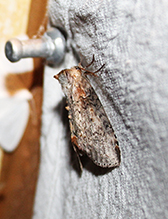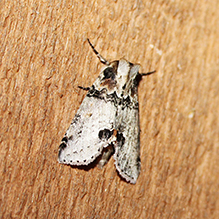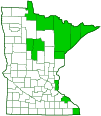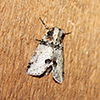Tufted thyatirine moth
(Pseudothyatira cymatophoroides)
Conservation • Description • Habitat • Ecology • Distribution • Taxonomy
| Hodges # | 6237 |
||
Conservation Status |
|||
| IUCN Red List | not listed |
||
| NatureServe | NNR - Unranked SNR - Unranked |
||
| Minnesota | not listed |
||
Description
Tufted thyatirine moth is a common, medium-sized, false owlet moth. It occurs throughout most of the United States and southern Canada, but it is absent from the Great Plains and the Great Basin.
Adults are found in deciduous and mixed forests and in shrublands. They are active from May to October in other parts of their range, but all records from Minnesota are from mid-June to mid-August. They are active at night and will come to lights. The larvae feed on the leaves of a wide variety of hardwood trees and shrubs.
Adults are ⅞″ to 1″ (23 to 25 mm) in length and have a wingspan of 1½″ to 1¾″ (38 to 44 mm). Moth size is often given in terms of forewing length, which in this case is ¾″ to 13⁄16″ (20 to 21 mm). There are two color forms, the “typical” form and the “expultrix” form, and they are very different. According to one source in the “literature”, the typical form is "much more frequent.” An observer in Minnesota indicates that the expultrix form seems more common in their area. The two forms are about equally represented in photos on BugGuide.net and iNaturalist.org.
On the typical form, the forewing is fairly long, and it is pointed at the tip. It is medium gray with faint reddish brown tinting near the base, near the tip, and in the cell. There is a black patch at the anal angle bordered on the outer edge by a small tuft of cinnamon brown scales. This is the feature that gives the species its common name. There is a also a black patch at the base and another near the tip. The patch near the tip is divided by a narrow white line. The antemedial (AM) line is represented by three jagged, blackish lines that contrast sharply with the background. The postmedial (PM) line is similar but it extends only a short distance inward from the leading edge of the wing (costal margin). The terminal line is represented by a line of small black spots, a single dot or wedge-shaped mark at the end of each vein. The hindwings are gray.
On the expultrix form, the forewings are ashy gray with lighter pinkish shading near the base at the anal angle. There is also pinkish shading in the median area around the circular spot (orbicular spot) and the kidney-shaped spot (reniform spot). The forewing lacks the dark contrasting markings of the typical form.
Size
Total length: ⅞″ to 1″ (23 to 25 mm)
Forewing length: ¾″ to 13⁄16″ (20 to 21 mm)
Wingspan: 1½″ to 1¾″ (38 to 44 mm)
Similar Species
Habitat
Deciduous and mixed forests and in shrublands
Ecology
Season
June to September in Minnesota
Behavior
Adults are active at night and will come to lights.
The larvae are solitary feeders.
Life Cycle
Adult Food
Larva Hosts
A wide variety of hardwood trees and shrubs
Distribution |
||
|
Sources |
|
| 9/20/2025 | ||
Occurrence |
||
|
||
Taxonomy
Order
Lepidoptera (Butterflies and Moths)
Superfamily
Drepanoidea (hooktip moths and allies)
Family
Drepanidae (hooktip and false owlet moths)
Subfamily
Thyatirinae (false owlet moths)
Tribe
Habrosynini
Genus
Pseudothyatira
Subordinate Taxa
Synonyms
Lacinia cymatophoroides
Thyatira cymatophoroides
Common Names
tufted thyatirid moth
tufted thyatirine moth
Glossary
Anal angle
In insects: The angle at the corner of a wing formed where the outer and inner margins meet.
Antemedial (AM) line
A thin line separating the basal area and the median area of the forewing of Lepidoptera.
Cell
In Lepidoptera: the large central area of the wing surrounded by veins.
Orbicular spot
A circular spot or outline in the upper median area near the antemedial line on the forewing of many moths.
Postmedial (PM) line
A thin line separating the median area and the postmedial area of the forewing of Lepidoptera.
Reniform spot
A kidney-shaped spot or outline in the lower median area near the PM line on the forewing of many moths.
Visitor Photos
Share your photo of this insect.
This button not working for you?
Simply email us at info@MinnesotaSeasons.com.
Attach one or more photos and, if you like, a caption.
Gary Walton |
||
… attached are photos of two forms of Pseudothyatira cymatophoroides (typical and expultrix) seen on different days during Moth Week this year. This is the first time I've seen the typical form. Expultrix seems more common here. |
||
 |
 |
|
| Pseudothyatira cymatophoroides (expultrix form) | Pseudothyatira cymatophoroides (typical form) |
|
MinnesotaSeasons.com Photos
|

Slideshows

Visitor Videos
Share your video of this insect.
This button not working for you?
Simply email us at info@MinnesotaSeasons.com.
Attach a video, a YouTube link, or a cloud storage link.
Other Videos

Visitor Sightings
Report a sighting of this insect.
This button not working for you?
Simply email us at info@MinnesotaSeasons.com.
Be sure to include a location.
Gary Walton
7/25/2025
Location: Carlton County
… attached are photos of two forms of Pseudothyatira cymatophoroides (typical and expultrix) seen on different days during Moth Week this year. This is the first time I've seen the typical form. Expultrix seems more common here.
Minnesota Seasons Sightings



